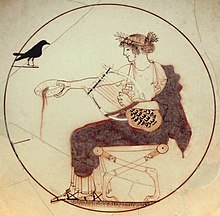
The few pottery exhibits of the Delphi Archaeological Museum include a famous shallow bowl (kylix) with an unusual depiction of the god Apollo. In the white-ground red-figure technique, it was found in a grave underneath the museum.
It is the work of an Attic workshop, around 480–470 BC. Scholars have suggested Euphronios or Onesimos as the painter, or described it as in the manner of the Pistoxenos Painter.[2] The scene depicted evokes the verse from the second hymn to Apollo found inscribed on the southern wall of the Treasury of the Athenians: "Sing for the gold-haired Pythios who aims far with his bow and arrow and plays nicely the lyre".
- ^ Apollo wearing a laurel or myrtle wreath, a white peplos and a red himation and sandals, seating on a lion-pawed diphros; he holds a kithara in his left hand and pours a libation with his right hand. Facing him, a black bird identified as a pigeon, a jackdaw, a crow (which may allude to his love affair with Coronis) or a raven (a mantic bird). Tondo of an Attic white-ground kylix attributed to the Pistoxenos Painter (or the Berlin Painter, or Onesimos). Diam. 18 cm (7 in.)
- ^ Beazley Archive, Vase 5522